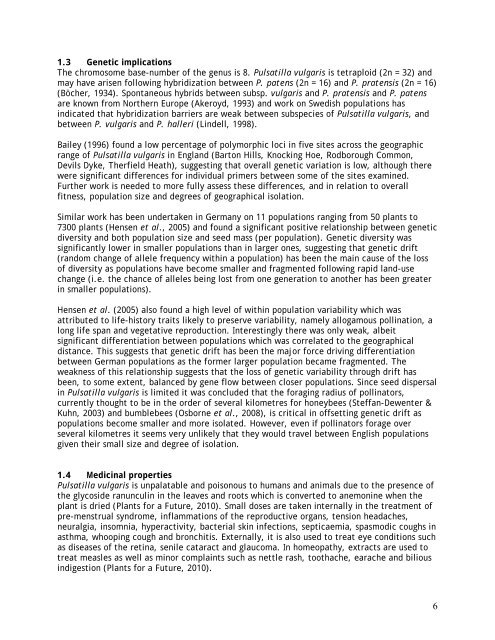Pulsatilla vulgaris (L.) Mill. - Plantlife
Pulsatilla vulgaris (L.) Mill. - Plantlife
Pulsatilla vulgaris (L.) Mill. - Plantlife
Create successful ePaper yourself
Turn your PDF publications into a flip-book with our unique Google optimized e-Paper software.
1.3 Genetic implications<br />
The chromosome base-number of the genus is 8. <strong>Pulsatilla</strong> <strong>vulgaris</strong> is tetraploid (2n = 32) and<br />
may have arisen following hybridization between P. patens (2n = 16) and P. pratensis (2n = 16)<br />
(Böcher, 1934). Spontaneous hybrids between subsp. <strong>vulgaris</strong> and P. pratensis and P. patens<br />
are known from Northern Europe (Akeroyd, 1993) and work on Swedish populations has<br />
indicated that hybridization barriers are weak between subspecies of <strong>Pulsatilla</strong> <strong>vulgaris</strong>, and<br />
between P. <strong>vulgaris</strong> and P. halleri (Lindell, 1998).<br />
Bailey (1996) found a low percentage of polymorphic loci in five sites across the geographic<br />
range of <strong>Pulsatilla</strong> <strong>vulgaris</strong> in England (Barton Hills, Knocking Hoe, Rodborough Common,<br />
Devils Dyke, Therfield Heath), suggesting that overall genetic variation is low, although there<br />
were significant differences for individual primers between some of the sites examined.<br />
Further work is needed to more fully assess these differences, and in relation to overall<br />
fitness, population size and degrees of geographical isolation.<br />
Similar work has been undertaken in Germany on 11 populations ranging from 50 plants to<br />
7300 plants (Hensen et al., 2005) and found a significant positive relationship between genetic<br />
diversity and both population size and seed mass (per population). Genetic diversity was<br />
significantly lower in smaller populations than in larger ones, suggesting that genetic drift<br />
(random change of allele frequency within a population) has been the main cause of the loss<br />
of diversity as populations have become smaller and fragmented following rapid land-use<br />
change (i.e. the chance of alleles being lost from one generation to another has been greater<br />
in smaller populations).<br />
Hensen et al. (2005) also found a high level of within population variability which was<br />
attributed to life-history traits likely to preserve variability, namely allogamous pollination, a<br />
long life span and vegetative reproduction. Interestingly there was only weak, albeit<br />
significant differentiation between populations which was correlated to the geographical<br />
distance. This suggests that genetic drift has been the major force driving differentiation<br />
between German populations as the former larger population became fragmented. The<br />
weakness of this relationship suggests that the loss of genetic variability through drift has<br />
been, to some extent, balanced by gene flow between closer populations. Since seed dispersal<br />
in <strong>Pulsatilla</strong> <strong>vulgaris</strong> is limited it was concluded that the foraging radius of pollinators,<br />
currently thought to be in the order of several kilometres for honeybees (Steffan-Dewenter &<br />
Kuhn, 2003) and bumblebees (Osborne et al., 2008), is critical in offsetting genetic drift as<br />
populations become smaller and more isolated. However, even if pollinators forage over<br />
several kilometres it seems very unlikely that they would travel between English populations<br />
given their small size and degree of isolation.<br />
1.4 Medicinal properties<br />
<strong>Pulsatilla</strong> <strong>vulgaris</strong> is unpalatable and poisonous to humans and animals due to the presence of<br />
the glycoside ranunculin in the leaves and roots which is converted to anemonine when the<br />
plant is dried (Plants for a Future, 2010). Small doses are taken internally in the treatment of<br />
pre-menstrual syndrome, inflammations of the reproductive organs, tension headaches,<br />
neuralgia, insomnia, hyperactivity, bacterial skin infections, septicaemia, spasmodic coughs in<br />
asthma, whooping cough and bronchitis. Externally, it is also used to treat eye conditions such<br />
as diseases of the retina, senile cataract and glaucoma. In homeopathy, extracts are used to<br />
treat measles as well as minor complaints such as nettle rash, toothache, earache and bilious<br />
indigestion (Plants for a Future, 2010).<br />
6

















